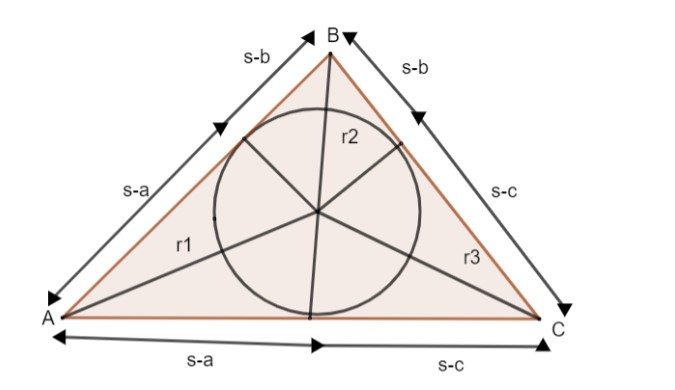Question
Question: Prove that \[{{r}_{1}}{{r}_{2}}{{r}_{3}}=r{{s}^{2}}\], where \[{{r}_{1}},{{r}_{2}}\]and \[{{r}_{3}}\...
Prove that r1r2r3=rs2, where r1,r2and r3is the radius of the exterior circle on side A, B and C.
Solution
Hint: Use heron’s formula to solve. Multiply the radius of these circles considered to prove it. Find the radius of r1,r2and r3. Prove the LHS by multiplying r1,r2and r3..
Complete step-by-step answer:
Let us consider that r1,r2and r3are radius of the circle, opposite to a, b and c of the triangle ABC.
Let the triangle be the area of the triangle ABC.
S is the sum of the length of the triangle ABC.
∴s=2a+b+c
Radius of the triangle, r=sum−oppositesidearea
∴radius of r1=s−aΔ
Similarly, r2=s−bΔand r3=s−cΔ
r1r2r3=(s−aΔ)(s−bΔ)(s−cΔ)
Where radius r1is opposite to the side ‘a’ of △ABC
radius r2is opposite to the side ‘b’ of △ABC
radius r3is opposite to the side ‘c’ of △ABC
∴r1r2r3=(s−a)(s−b)(s−c)Δ3−(1)
By using, Heron’s formula, we can take the area of the triangle, when the length of all three sides of triangle are known:
Δ=s(s−a)(s−b)(s−c)−(2)
The figure shows the geometrical significance of (s−a),(s−b)and (s−c).

In equation (1) multiply the numerator & denominator by ‘s’.
r1r2r3=s×(s−a)(s−b)(s−c)Δ3×s−(3)
We know, Δ=s(s−a)(s−b)(s−c)
Squaring equation (2) on both sides
Δ2=s(s−a)(s−b)(s−c)−(4)
Substitute the value of (4) in (3)
=Δ2sΔ3=sΔ−(5)
Multiply numerator and denominator by ‘s’ in equation (5)
=s2sΔ
We know the radius in circle, r = a / (sum of lengths of triangle) = sa
By substituting the same, we get
r1r2r3=rs2.
Note: Remember to use heron’s formula to simplify equation (1).
